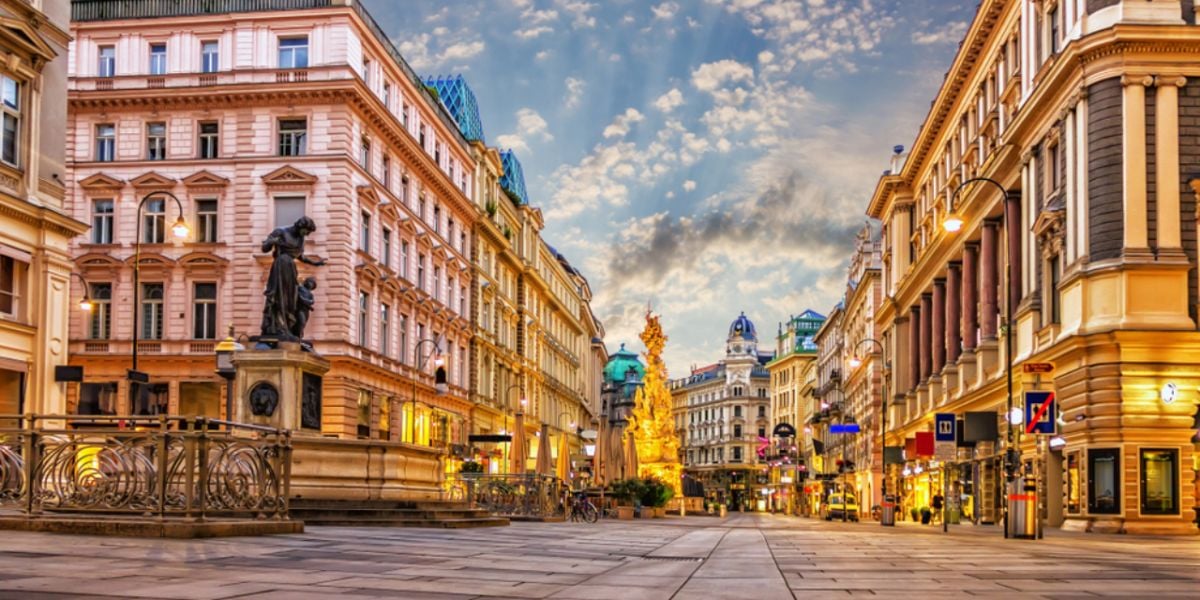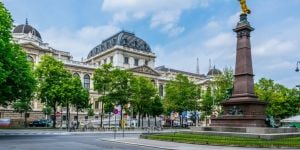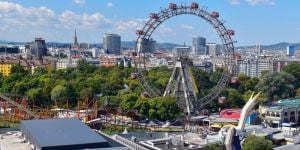
Vienna might seem like a rather scenic and calm city with its beautiful historical buildings and classy looks. Don't get fooled, though! The city has a vibrant underground music and art scene! To help you choose the best place to live in, here is an insight into Vienna's popular neighbourhoods.
Vienna offers more than just aesthetic appeal; it is a city with distinctive character spread across its 23 districts. Each district possesses its unique vibe and atmosphere. So if you're looking for accommodation in Vienna and are not sure what district is most appropriate, look no further. Here is a rundown of the most popular neighborhoods in Vienna.
If you come across an address in Vienna and are unsure about which district it belongs to, you can use the middle two digits of the postcode to determine the specific district.
Before we delve into detailed information about the different districts, it's essential to acknowledge that finding a flat or house in Vienna can vary considerably depending on the district and your preferences. Unfortunately, over the last 15 years, rents in Vienna have risen by 40%, making the housing market more challenging for many people.
Innere Stadt
The journey through Vienna begins in the heart of the city with the renowned "First District," identified by postcode 1010. Referred to as the "Innere Stadt" (Inner City), it encompasses the most central area of Vienna. Here, you will find an array of significant attractions, including the parliament, the town hall, and the iconic St. Stephen's Cathedral. A convenient way to begin exploring is by alighting from the metro directly in front of the cathedral and embarking on a stroll.
As you walk along the vibrant "Kärntner Strasse," a bustling shopping street, you will eventually arrive at the captivating Vienna State Opera House. This enchanting landmark serves as a magnificent endpoint for your journey through the First District.
The first district of Vienna is very small and encompasses the historic old town. Due to its central location and historical significance, it is considered unaffordable for most people to live in. Finding a vacant flat for rent in this district can be quite challenging, and it often requires a stroke of luck to secure one.
Leopoldstadt
The second district, Leopoldstadt has become very famous over the last few years and is definitely amongst the up-and-coming neighborhoods. It is full of small designer shops, hip coffee shops, and trendy restaurants and bars. Prater Park is also located in this district as well as the Jewish quarter.
In the past, the second district of Vienna was known for being relatively affordable. However, over the years, it has transformed into one of the most sought-after districts, mainly due to its proximity to the city center and the presence of extensive green spaces. As a result, the demand for housing in this district has increased significantly.
Finding flats in the newer parts of the second district, especially near the Prater and Messe Wien (Vienna Exhibition and Congress Center), or around the old railway station area, is relatively easier compared to the older parts of the district. The reason is that ongoing construction and development projects in these areas have led to increased availability of housing options.
The combination of its central location, green areas, and ongoing development projects has made the second district a highly attractive and popular choice for many individuals looking for accommodation in Vienna. Consequently, housing prices have likely risen as well, but it remains a preferred district for its appealing features and convenience.
Landstrasse
The third district, Landstrasse, houses the beautiful "Hundertwasserhaus” and several parks. It allows you to escape the busy city life for a short moment while staying right in its centre. This part of town shows you the very charming side of Vienna, as almost every street has some other monument or church to offer. You will also find the metro and train station "Wien Mitte" in this district, which conveniently connects the city and the airport through the "CAT- City Airport Train."
The third district of Vienna is highly favored by expats primarily because of its central location and the vibrant market called Rochusmarkt. The district's central position makes it convenient for accessing various amenities, Vienna's public transport, and cultural attractions, making it an attractive choice for many foreigners living in Vienna.
Wieden
The fourth district (Wieden) is one of the most underrated ones, as it doesn't have any major tourist attractions, which is also the reason why it is just the perfect place to live. You can be within 10 minutes in the very center of Vienna, as this district is right next to the First District and only separated by a big street.
Margareten
The fifth district (Margareten) is the following one and used to be one of the most affordable ones among the inner areas. In recent years, rents went up because people started to realize their potential. They also began to appreciate its closeness to the center while being tucked away from the hustle and bustle.
Mariahilf and Neubau
The sixth district (Mariahilf) and its direct neighbor the seventh district (Neubau) are the places to be if you are into hip boutiques and bars that serve any plant-based milk with your matcha latte. The two zones are divided through the famous Maria Hilfer Strasse, a very long shopping street with all kinds of retail stores.
Josefstadt and Alsergrund
The eighth (Josefstadt) and ninth districts (Alsergrund) are also pretty good neighborhoods for living. The two are among the smallest districts in the city. They do not have very many green spaces beside the ninth district leading to the Danube Canal, but they do have a lot of beautiful Fin-de-siècle (the years around 1900) buildings. Rents tend to be very high, though, so if you are on a budget, it could get hard to find something that matches your purse.
Finding accommodation in the 4th to 9th districts
Districts 4 to 9 in Vienna are known for their vibrant atmosphere, with numerous pubs, quaint shops, and charming alleys. While they may not be considered cheap in terms of housing costs, they offer a lively and appealing urban experience.
As you venture a bit further away from the city center in these districts, you might find slightly more affordable rental options. The proximity to the city center often commands higher rents, so moving away from the central areas can result in cost savings.
Another factor that influences the rental prices in these districts is the availability of nearby public transportation, particularly the underground (subway) system. Districts with convenient access to the subway tend to have higher rental prices due to the added convenience and accessibility to the rest of the city.
In summary, districts 4 to 9 in Vienna are characterized by their lively atmosphere, filled with pubs, shops, and picturesque alleys. While they may not be the cheapest areas to live in, more affordable housing options can be found as you move a bit farther from the city center. Additionally, the presence of nearby public transportation, particularly the underground, can impact the rental prices in these districts.
Favoriten
The tenth district (Favoriten) offers one essential building, the Central Train Station of Vienna. It connects the city with the rest of Austria and is also one of the most significant links within the town. Over the past years, the vicinity around the main railway station in Vienna has undergone significant development, with the emergence of numerous modern tall buildings. This transformation has attracted many families and young people, prompting them to choose this newly developed area as their new home in the city. Moreover, a little further away, you can discover the expansive Oberlaa Park, adding to the appeal of the surroundings.
Simmering
The eleventh district (Simmering) is a bit outside of the center but still easily accessible by metro line U3. At the so-called "Arena Wien" you will find some of the best open-air concerts Vienna has to offer! The eleventh district is also the one closest to the airport.
Meidling
The twelfth district (Meidling) is known to be a working-class, multicultural district with affordable rents. In that area, you'll also come across the renowned "Alterlaa" complex, celebrated for its uniqueness. Constructed in the 1970s and 1980s, this complex stands out with its large terraces equipped with planting troughs for the residents' use. Approximately 9,000 people reside in this complex, which is conveniently accessible via subway U6. Notably, the iconic Schönbrunn Palace and the picturesque Schönbrunn Palace Park, frequented by many for jogging, are also situated nearby.
Hietzing
The thirteenth district (Hietzing) is one of the most beautiful neighborhoods of the entire city. It is very green, has a local flair and also houses the famous "Schönbrunn Palace" and the zoo, which is the oldest in Europe! The area boasts a higher number of family houses compared to other districts, making it an ideal choice for those seeking a peaceful and green environment. However, it is essential to note that this district is also considered one of the most expensive areas in Vienna. If you value tranquillity and proximity to nature, both this district and the 19th district would be excellent options for you.
Other districts in Vienna
The fourteenth to nineteenth districts are located along the left side outside of the "Gürtel" - which is a street that surrounds the entire city like a belt, hence the name.
The more inner parts of these districts are all super centrally located, whereas the outer parts are very suburban and offer the possibility of buying whole house in Vienna and living a life within the city with a touch of countryside vibe. Many students live in these parts of Vienna, and it has a very colorful and multicultural flair. You can go and buy your veggies right from one of the uncountable food markets these districts have to offer and enjoy a variety of cuisines from all over the world.
If living close to the city center is a priority for you, the twentieth, twenty-first, twenty-second, and twenty-third districts may be a bit farther away, but they still offer good connectivity to the city center, primarily due to their proximity to the subway system. If a suburb with a hint of big city life is what you are looking for, then definitely try your luck in one of these districts!
If you are searching for a larger or more affordable flat and consider having a private parking space as essential, the outer districts 10 to 23 in Vienna are better options. These districts often feature newer housing developments that may include amenities such as balconies, gardens, and bicycle rooms.
The outer districts benefit from good transportation connections, with access to both the U-Bahn (subway) and S-Bahn (urban railway) systems. This enables convenient and relatively quick commuting to the city center and other parts of Vienna.
Living in the outer districts can offer a more spacious and cost-effective living environment while still providing the necessary transportation options for easy access to the city's amenities and activities.
In recent years, districts 20 to 22 have seen a surge in popularity due to several factors. Firstly, their convenient proximity to the Danube and the Danube Island makes them highly desirable. Additionally, these districts boast many modern buildings, attracting residents seeking contemporary living spaces. Moreover, you can find important institutions like the United Nations (UN) and the Austria Center event center in these areas, along with numerous large companies.
Give yourself some time and be patient; Vienna has the right spot for everyone!
We do our best to provide accurate and up to date information. However, if you have noticed any inaccuracies in this article, please let us know in the comments section below.








